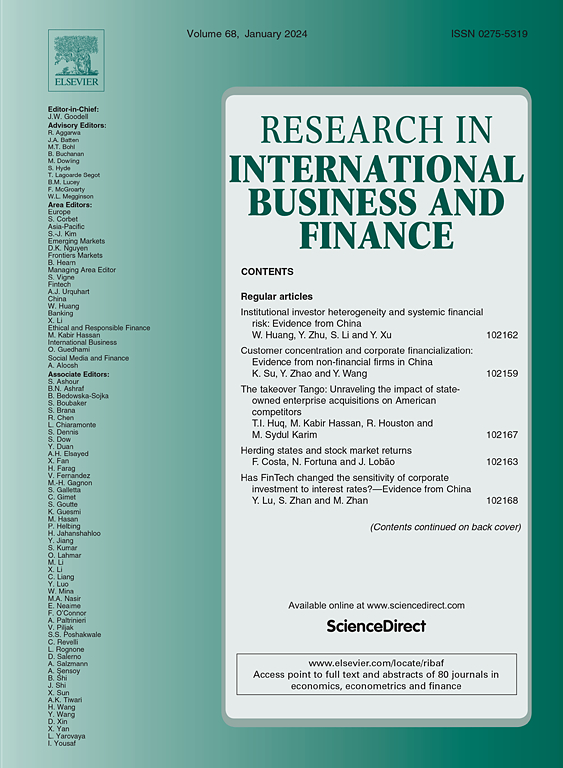Decoding investment strategies across agricultural commodities, Islamic equities, and Sukuk markets
IF 6.9
2区 经济学
Q1 BUSINESS, FINANCE
Research in International Business and Finance
Pub Date : 2025-08-01
DOI:10.1016/j.ribaf.2025.103097
引用次数: 0
Abstract
This study develops a novel quantile time-frequency connectedness framework that enables the investigation of different investment strategies among agricultural commodities, Islamic equities, and Sukuk markets. Additionally, the study analyses relative variation of price quotations using (DCC-t-Copula) to identify the ideal portfolio weights and hedging ratios between agricultural commodities, Islamic equities, and Sukuk markets. This approach helps us understand connectedness patterns between the underlying variables under different market conditions. To this end, the study utilised the dynamic quantile time-frequency spillover approach to examine connectedness and investment strategies among ten agricultural commodities, six Islamic stock market indices, and five pre-eminent Sukuk indices. Empirical findings indicate that farming commodities and Islamic sukuk indices are mainly the net receivers of shocks. In contrast, the Islamic equity markets are the main net transmitters during the short and long run under normal market conditions. We also find that the total connectedness index among the selected indices is higher during the short-run dynamics than the long-run at different quantiles considered in the study. These findings will help investors, financial analysts, regulators, and portfolio managers understand comovements and volatility spillover patterns among the Islamic equity indices, Sukuk, and agricultural commodities to manage risk and portfolio diversification.
解读农产品、伊斯兰股票和伊斯兰债券市场的投资策略
本研究开发了一种新颖的分位数时频连通性框架,可以对农产品、伊斯兰股票和伊斯兰债券市场之间的不同投资策略进行调查。此外,本研究使用(DCC-t-Copula)分析了价格报价的相对变化,以确定农产品、伊斯兰股票和伊斯兰债券市场之间的理想投资组合权重和对冲比率。这种方法帮助我们理解不同市场条件下潜在变量之间的联系模式。为此,本研究采用动态分位数时频溢出方法,考察了10种农产品、6种伊斯兰股票市场指数和5种卓越的伊斯兰债券指数之间的连通性和投资策略。实证结果表明,农产品和伊斯兰债券指数主要是冲击的净接受者。相比之下,在正常市场条件下,伊斯兰股票市场是短期和长期的主要净传播者。我们还发现,在研究中考虑的不同分位数上,所选指数之间的总连通性指数在短期动态中高于长期动态。这些发现将有助于投资者、金融分析师、监管机构和投资组合经理了解伊斯兰股票指数、伊斯兰债券和农产品之间的变动和波动溢出模式,以管理风险和投资组合多样化。
本文章由计算机程序翻译,如有差异,请以英文原文为准。
求助全文
约1分钟内获得全文
求助全文
来源期刊

Research in International Business and Finance
BUSINESS, FINANCE-
CiteScore
11.20
自引率
9.20%
发文量
240
期刊介绍:
Research in International Business and Finance (RIBAF) seeks to consolidate its position as a premier scholarly vehicle of academic finance. The Journal publishes high quality, insightful, well-written papers that explore current and new issues in international finance. Papers that foster dialogue, innovation, and intellectual risk-taking in financial studies; as well as shed light on the interaction between finance and broader societal concerns are particularly appreciated. The Journal welcomes submissions that seek to expand the boundaries of academic finance and otherwise challenge the discipline. Papers studying finance using a variety of methodologies; as well as interdisciplinary studies will be considered for publication. Papers that examine topical issues using extensive international data sets are welcome. Single-country studies can also be considered for publication provided that they develop novel methodological and theoretical approaches or fall within the Journal''s priority themes. It is especially important that single-country studies communicate to the reader why the particular chosen country is especially relevant to the issue being investigated. [...] The scope of topics that are most interesting to RIBAF readers include the following: -Financial markets and institutions -Financial practices and sustainability -The impact of national culture on finance -The impact of formal and informal institutions on finance -Privatizations, public financing, and nonprofit issues in finance -Interdisciplinary financial studies -Finance and international development -International financial crises and regulation -Financialization studies -International financial integration and architecture -Behavioral aspects in finance -Consumer finance -Methodologies and conceptualization issues related to finance
 求助内容:
求助内容: 应助结果提醒方式:
应助结果提醒方式:


